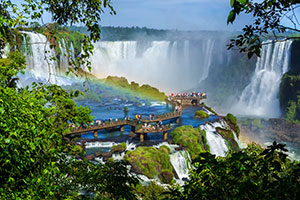Exploring the South Shetlands and along the Peninsula, this extensive Antarctica cruise also takes you to the Western and Eastern Falklands, rich with history and diverse fauna. Extremely isolated, South Georgia is the highlight of this unique voyage, with 4 days to explore the island's must-see sites including the Salisbury Plain, nicknamed the "Serengeti of the South" for its abundant wildlife!
Drake Passage
Drake Passage
The Drake Passage is the body of water between the southern tip of South America at Cape Horn and Antarctica. It forms part of the Southern Ocean. It is named after 16th century English explorer Sir Francis Drake.
|
|
Antarctic Sound
Antarctic Sound
Antarctic Sound also know as, Iceberg Alley, is accompanied my views that can only be described as amazing. Huge open skies, enormous icebergs, low clouds, sudden weather changes and constant surprises from the hugely abundant wildlife you see will keep you in a constant state of awe. Travellers will discover colonies of Adelie penguins, and ice floes also provide a floating resting spot for various seals.
|
|
Elephant Island
Elephant Island
When the Endurance was crushed by the ice of the Weddell Sea, it is on Elephant Island in the South Shetlands that Sir Ernest Shackleton and his crew sought refuge, floating on three small boats through mammoth icebergs and landing between steep cliffs. For 105 days, 22 members of the crew endured hardship as Shackleton pressed forth on a harrowing search for help. Here, expedition photographer, Frank Hurley, took his striking photo of the crew waving at Shackleton as he set off.
|
|
Antarctic Peninsula
Antarctic Peninsula
The Antarctic Peninsula thrusts out past the Antarctic Circle, lunging vainly towards the Andes, across the infamous Drake Passage. As far as the Antarctic is concerned, the peninsula is the most densely populated location on the continent, sprinkled with vast research bases and minute outposts alike. At the height of the summer season, the human population numbers over 3,000 - not counting tourists. That figure shrinks to less than 1,000 during the intensely chilly winter.
|
|
South Georgia
South Georgia
Southeast of the Falklands, South Georgia is lost in the midst of the Southern Ocean, one of the most remote regions on earth. South Georgia's climate is dominated by the freezing effects of the Antarctic continent 1,000 miles to the south. Glaciers coat more than half the island, and the scenery is spectacular, as if the Alps had been dropped down in the south Atlantic. The only access is by sea, and the journey can take up to 10 days battling against south Atlantic gales.
|
Destination Guide
|
Carcass Island
Carcass Island
Lying to the northwest of the Falklands archipelago, is the scenic little island of Carcass. The island's rolling hills and low cliffs are home to a number of wildlife, and visitors can view penguin and duck colonies. Both the north and south of the island provide great hiking opportunities, beaches (some good beachcombing), interesting flora, and sheltered dunes which make great picnic spots.
|
|
West Point Island
West Point Island
West Point is one of the Falkland Islands in the South Atlantic Ocean. With a more rugged lifestyle than the military school of the same name, this small island has a stark beauty. Soaring tufts of tussock grass - some nearly six feet tall provide a sheltering habitat for rockhopper and Magellanic penguins and a large albatross colony.
|
|
Falkland Islands
Falkland Islands
Though next door to South America and Antarctica, the Falklands are British through and through, with peat fires burning in every hearth and teatimes to set your clock by. Located northeast of Cape Horn, the Falklands Islands (also known as Islas Malvinas) are the most easily accessible sub-Antarctic islands. Their off-the-beaten-track location and intriguing history make for a unique destination. A rough stone road has been built most of the way to Gypsy Cove now, and vehicles may be available for private tours. Visits to Cape Pembroke Lighthouse or to some of the battlefield sites may also be possible.
|
Destination Guide
|
Tierra del Fuego
Tierra del Fuego
Surrounded by the Atlantic and Pacific Oceans and the Strait of Magellan, the stunning archipelago of Tierra del Fuego is part of the vast region of Patagonia in Argentina and Chile. The Parque Nacional Tierra del Fuego offers magnificent mountains, hanging glaciers, sphagnum bogs, clear lakes and rushing rivers. Here you may see wildlife ranging from Andean condors to beavers, sea lions and albatross.
|
Destination Guide
|
Ushuaia
Ushuaia
The world's southernmost city, Ushuaia overlooks Beagle Channel, named after the ship that took Charles Darwin to the bottom of the world. Founded just over one hundred years ago, this rustic town is situated amidst incredible snowcapped mountains, dramatic waterfalls, massive glaciers, and a forest known for its red foliage. Tierra del Fuego, the "Land of Fire," twelve miles to the west of Ushuaia, is known for its glacial landscape and its national park, which is a bird-watcher's paradise.
|
Destination Guide
|


 626.915.7636
626.915.7636

